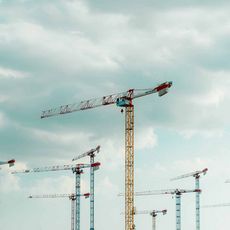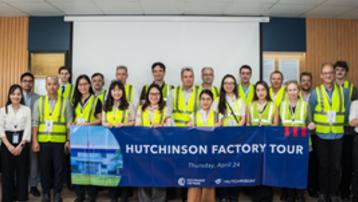How green buildings can contribute to a greener Vietnam?

The government of Vietnam has made strong commitments to reduce its carbon footprint. On a visit to Glasgow to join the international COP-26 environmental conference in November 2022, Prime Minister Pham Minh Chinh promised to hit net zero carbon emissions in 2050.
This is a positive and ambitious target. But transitioning to a cleaner, greener, more sustainable Vietnam means reducing the environmental impact of all sectors – not just the traditional fossil-fuel companies and power-intensive industries. In other words, reducing carbon emissions is not just about building more solar panels or reducing single-use plastics. Companies right across the economic spectrum need to do their bit.
For instance, buildings are some of the biggest sources of global carbon emissions, whether during their construction or through the light, heat, and power consumed throughout their lifetime. The United Nations estimates that buildings account for as much as one-third of CO2 emissions worldwide and for around half of Vietnam’s raw materials, a third of its power production, a quarter of its lumber, and just under one-fifth of its fresh water resources.
With Vietnam continuing to urbanize at scale and pace, so-called ‘green buildings’ will be one of the biggest priorities in decarbonization over the coming decades. In other words, how sustainable our buildings are will have a considerable impact on the CO2 emissions of the future.
Green buildings and sustainable construction
Green buildings aim to address this problem. Throughout their lifetime – from design to construction and from occupation right through to destruction – green buildings aim to be resource efficient, low consumption, and to minimize waste. In doing so, green buildings help to reduce emissions and protect the environment.
So far, however, sustainable construction in Vietnam remains rare. The Vietnam Green Building Council (VGBC) created the LOTUS green-building certification in 2010 to promote sustainable construction in Vietnam. However, to date, most green buildings tend to be foreign-owned and based in major cities like Hanoi and HCMC.

The International Finance Corporation (IFC) found that, in 2019, Vietnam had 116 ‘certified’ green buildings – with certifications like LOTUS (Vietnam) and LEED (US) confirming their sustainable status. Over half (51 percent) of these buildings were residential houses, with industrial real estate making up almost a third (28 percent) and office buildings representing a further ten percent. Though progress remains slow, the number of green buildings continues to rise, reaching 233 projects in 2022.
What’s stopping sustainable construction?
One of the biggest barriers to green buildings seems to be a lack of awareness. Despite misconceptions about much higher capital investment at the construction stage, the small (three to five percent) additional up-front costs can be recouped through much lower power consumption during the lifetime of the building – between 25 and 67 percent, according to some estimates.
For instance, green building solutions in the high-rise CapitaLand Feliz En Vista apartments in HCMC are predicted to reduce power and light consumption, amounting to a USD 600,000 annual saving. Meanwhile, local companies often lack practical knowledge and skills in green and sustainable construction.

The government is keen to promote green buildings and close the gap with other countries in the region where sustainable construction is more common. In that spirit, the Vietnam ‘Green Building Week’ took place last October, bringing together thousands of investors, developers, architects, consultants, building companies, government representatives, and other stakeholders to raise awareness of green buildings and discuss sustainable solutions in the construction sector.
The government has also issued a range of initiatives and regulations to promote green buildings and encourage sustainable development. For instance, in 2018, the ‘Urban Green Growth Development Plan to 2030’ was published, aiming to reduce greenhouse gas emissions and improve climate-change resilience in urban areas.
Likewise, in 2021, the Minister of Construction also approved the action plan for the construction sector on climate change response for 2022-2030, with a vision to 2050, to help Vietnam achieve its COP-26 commitments.
The commercial case for green buildings
Green buildings are not just about protecting the environment and reducing carbon emissions – important though that is. There are also significant commercial opportunities for investors in sustainable construction.
The IFC estimates that the green building sector in Vietnam could be worth as much as USD 80 billion to investors, and represent up to 30 percent of the market in 2025.
Meanwhile, real estate services firm Knight Frank Vietnam reports that green-certified buildings in HCMC command 18 percent higher rental incomes than non-certified buildings of an equivalent size. So, in short, there are considerable opportunities for French companies not just in traditional construction and materials but also in the design, architecture, and real estate industries that support green buildings.

Meanwhile, companies as well as countries have net-zero ambitions. Multinational enterprises have also made significant commitments to reduce their carbon footprint as part of their Environmental, Social, and Governance (ESG) strategies. For this reason, MNCs are looking to lease green-certified office buildings or industrial real estate in Vietnam to meet these commitments; not least because listed companies now need to include ESG reviews in their annual reports.
Together, these make a compelling commercial as well as environmental case for companies to embrace the green building trend in Vietnam.
This article is part of CCIFV magazine "Connect #11: Building Vietnam's Tomorrow: Challenges and trends in Construction"

Keep up to date with the latest news from the construction sector
Join CCIFV's construction sector committee to exchange ideas with our business community and access the most relevant information.
Learn more
![[Translate to Anglais:] [Translate to Anglais:]](http://aws-a.medias-ccifi.org/fileadmin/_processed_/7/5/csm_gridasia-viglacera-bac-ninh-pers0220231214195526_92c824cbbd.jpg)
